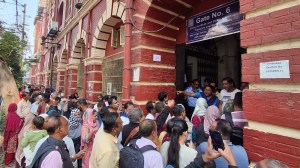It will not be read this year, or this decade, or even this century. Amitav Ghosh’s next work will remain locked in a room in the Norwegian capital of Oslo until the year 2114. It joins a growing collection of sealed manuscripts by internationally acclaimed writers, including Margaret Atwood (The Handmaid’s Tale) and Han Kang (The Vegetarian), which are part of a 100-year artwork Framtidsbiblioteket (Future Library), a project in which words and trees grow together toward an audience not yet born.
The 68-year-old Indian novelist, whose works have traced the histories of empire, migration, and ecological change, was announced as the 12th author to join the century-long literary time capsule founded by Scottish artist Katie Paterson.

His yet-untitled work will be printed on paper milled from the very trees planted for the project in Nordmarka, a forest on the northern edge of the Norwegian capital. These trees will supply paper for an anthology of books that will be published 100 years later. In the meantime, one writer is invited every year to submit a manuscript, which is sealed and locked in Oslo’s main public library, unread.
According to the Trust, Ghosh was chosen “for his deeply resonant literary voice and his longstanding engagement with themes of ecology, history, and time.”
For Ghosh, whose recent books have wrestled with the climate crisis, the project’s premise feels like a natural extension of his concerns. “The Future Library compels us to think beyond our lifetimes, to imagine readers who have not yet been born. It is particularly significant for me that the project has a forest at its core, because for a long time now, I have been writing about a forest, albeit of an entirely different kind: the great mangrove forest known as the Sundarban,” he said in a statement.
“To be invited to participate in the Future Library project is both a profound honour and a humbling act of trust,” Ghosh said, adding, “It will be an exciting challenge to make a connection between the forests of the far north and those of the tropics, at this time of extreme planetary crisis. I am moved to be part of a work that intertwines ecology, literature, and patience on such a monumental scale.”
The forest as printing press
 The Silent Room, opened on 12 June 2022, is situated on the top floor of the library alongside the special collection of books and archives. Facing the Future Library forest, it is a small and intimate space, welcoming only a few visitors at a time. (Future Library)
The Silent Room, opened on 12 June 2022, is situated on the top floor of the library alongside the special collection of books and archives. Facing the Future Library forest, it is a small and intimate space, welcoming only a few visitors at a time. (Future Library)
The Future Library began in 2014, when Paterson planted 1,000 Norwegian spruce trees in Nordmarka. The seedlings, chosen from the forest’s own genetic stock, were sealed in wax to protect against pests. A century later, they would be cut down and pulped for paper. By then, the library will hold 100 manuscripts, one added each year by an invited author, the only limit being that the work must remain unpublished and unread until the grand unveiling. “It’s like a relay across time,” Paterson said in an interview, “with each writer passing the baton to someone they’ll never meet.”
Story continues below this ad
The manuscripts are kept in “The Silent Room” at Deichman Bjørvika, Oslo’s sleek waterfront library. Visitors may enter, but cannot open the sealed boxes. Only the author’s name, title, and year of contribution are visible.
A roll call of literary ghosts-in-waiting
The project’s first contributor was Margaret Atwood in 2014. She likened the invitation to being asked for a kidney by a family member: “You either say yes or no immediately.” She said yes. In the decade since, the roster has grown to include David Mitchell, Sjón, Elif Shafak, Han Kang, Karl Ove Knausgård, Ocean Vuong, Tsitsi Dangarembga, Judith Schalansky, and Valeria Luiselli.
Each book represents a moment in time, chosen by the Trust that seeks to capture the diversity, urgencies, and preoccupations of each passing year. In this way, the Future Library can be seen as an artwork, a slow-growing portrait of a century’s thought.
Ghosh’s inclusion is fitting for a project rooted in ecology. In novels such as The Hungry Tide and Gun Island, and in nonfiction such as The Great Derangement, he has argued that literature must grapple more directly with environmental catastrophe. The Future Library’s century-long arc is a rare instance of an artistic form adopting the same temporal scale as the planetary systems it invokes.
A bet on the future
Paterson is careful to say that the Future Library is not a work of activism per se. “It’s not a directly environmental statement,” she has explained, “but it involves ecology, the interconnectedness of things — those living now and still to come.”
Story continues below this ad
The optimism here is almost radical. A hundred years is a long time in an era when political decisions are made in election cycles and media narratives turn over in days. To succeed, the project assumes not only that humanity will survive into 2114, but that Oslo will still exist, that forests will remain, and that the printed book will still be an intelligible and valued object.
When Atwood contributed her manuscript, she wondered in her accompanying essay, which is available on the website: “Will there be a ‘Norway’? Will there be a ‘forest’? Will there be a ‘library’?” It is, she concluded, “hopeful to believe” that all of these will endure.
Living with the unread
 Margret Atwood at the Silent Room in Future Library
Margret Atwood at the Silent Room in Future Library
For most art, completion coincides with public reception. Here, the act of creation is severed from its audience by the length of a lifetime. Paterson herself will not see the anthology printed. “It is important that I do not see it fully realised,” she has said. “It is a work conceived for an unknown, future generation.”
Ghosh’s manuscript will sit in its box for 89 years. By the time it is opened, the geopolitical maps, the coastlines, and perhaps even the climate will have altered beyond recognition. It may read as prophecy, anachronism, or something in between.
Story continues below this ad
For the authors, the act of writing becomes a kind of message in a bottle, except the bottle is an entire forest, and the message will wash ashore not in years, but in eras. When David Mitchell submitted his manuscript in 2015, he called it “an exercise in trust.” Neither the project’s founder, Katie Paterson, nor coordinator Anne Beate Hovind, nor Mitchell himself, nor the next thirty or forty authors, or even the foresters tending the spruce plantation will be alive to see the books published in 2114.
They must rely on future generations to guide the project through political upheavals, climate change, budget cuts, and even “zombie apocalypses.” They must trust that “digital archaeologists” will be able to retrieve files from ancient USB sticks, and that no one will turn up at the Future Forest handover ceremony with a sheaf of blank pages, he says. Above all, Mitchell says, “We trust that our trust is not misplaced.”
Pilgrimage to the future
For those who want to see the project in its infancy, the Future Library forest is open to visitors. From the metro stop at Frognerseteren, it is a 30-minute hike along marked trails. The geo-coordinates — 59°59’10.8″N 10°41’48.7″E — are public.
It is, perhaps, the most unusual library in the world with no catalog to browse, no shelves to scan, no books to check out. Just the promise that somewhere between the trees, a century’s worth of words is waiting.



 The Silent Room, opened on 12 June 2022, is situated on the top floor of the library alongside the special collection of books and archives. Facing the Future Library forest, it is a small and intimate space, welcoming only a few visitors at a time. (Future Library)
The Silent Room, opened on 12 June 2022, is situated on the top floor of the library alongside the special collection of books and archives. Facing the Future Library forest, it is a small and intimate space, welcoming only a few visitors at a time. (Future Library) Margret Atwood at the Silent Room in Future Library
Margret Atwood at the Silent Room in Future Library





























